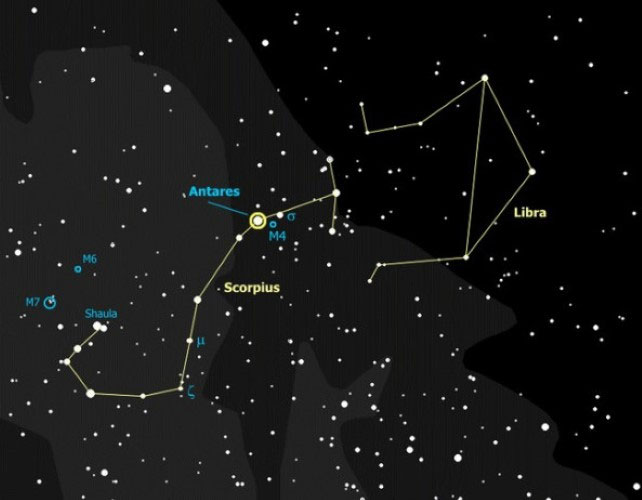Constellations and asterisms are two concepts that can be quite difficult to distinguish. For many years, these concepts were not clearly differentiated, leading to confusion and inaccuracies.
Constellations are Collections of Asterisms
An asterism is a general term that refers to any group of stars connected by imaginary lines to form any shape. The images formed by these stars can be derived from a major cultural context, a classification by any author, or even just a fun convention in the imagination of children.
As we know, the number of stars visible to the naked eye on a clear night is just over 6,000 (under ideal conditions), and around 20,000 stars when considering the total number visible over a year.

Simulation of constellations in the universe.
In simpler terms, our entire sky is almost fixed (with changes due to the Solar System’s movement around the galactic center and the birth/death of certain stars, but these changes are minimal). This means that regardless of any region or culture, the number of stars in the sky and their arrangement is always the same for observers.
When an observer uses their imagination to connect relatively nearby bright stars and assigns them a specific image, that group of stars becomes an “asterism.”
Initially, when humanity had not yet developed, human understanding depended on certain prominent scientists, and these connected groups of stars were mostly attributed to well-known thinkers and scientists, so these “asterisms” were commonly referred to as constellations.
However, by the early 20th century, when the conventions and classifications of constellations were standardized by astronomers, the concept of a constellation became more precise.
According to modern conventions, a constellation is not just imaginary lines connecting bright stars; each constellation represents a region of the sky it occupies.
Today, based on global consensus, our list of constellations includes 88 constellations, dividing the celestial sphere into 88 regions of varying sizes and shapes. Any star (including those discovered later through telescopes) that falls within the region of a specific constellation is considered a member of that constellation.
Common Misunderstandings
Thus, a constellation is a collection of asterisms, and in modern astronomy, only the list of constellations is officially recognized. As defined, an asterism can be imagined by anyone from any culture or profession, making their number infinite. Below, I will provide some typical examples of asterisms that are often misunderstood in Vietnam.
The group of seven bright stars in the northern sky forming the shape of a chair (or resembling a water dipper to some) belongs to the constellation Ursa Major (Great Bear), which corresponds to the Eastern constellation of the Northern Dipper. Many people mistakenly believe that the Northern Dipper and Ursa Major are the same, but this interpretation is incorrect.
The constellation Ursa Major has many stars and occupies a much larger area of the sky than the Northern Dipper of the East; the seven stars of the Northern Dipper are merely its brightest stars. In Western culture, these seven stars are referred to as the Big Dipper. Only the Big Dipper and the Northern Dipper overlap, and today they are considered an asterism, not a constellation.
The Pleiades star cluster, also known as M45, occupies a significant area of the sky and is the most clearly visible star cluster to the naked eye. Some Vietnamese sources translate it as “the seven stars constellation,” which is misleading because it is not recognized in the list of 88 constellations of modern astronomy. In terms of celestial classification, it is a star cluster—a region with many stars directly linked by gravity—while visually, it is also an asterism.
The Scorpion group of stars consists mainly of stars from the constellation Scorpius (one of the zodiac constellations), while their stars do not match.
The Scorpion is merely a group of stars that ancient Vietnamese referred to, and since the stars do not correspond, it does not align with Scorpius (the Scorpion); therefore, it is just a group of stars, not a constellation, and thus cannot be considered part of the zodiac.
The constellation Sagittarius is one of the zodiac constellations, often referred to as the Archer, stemming from the naming conventions of Vietnamese astronomers in the past. This constellation resembles an archer drawing a bow; however, this naming reveals a problem as it shares a name and can easily be confused with the constellation Centaurus, which also has the shape of an archer. Vietnamese authors have corrected this error by adding the word “half” to the front of Centaurus, resulting in the name “Half Archer.”
It is important to note that the term “Half Archer” is meaningless, as the image of the centaur is complete, not half. Secondly, to maintain consistency with the global community, we should pay attention to linguistic uniformity. All official astronomical documents internationally translate Sagittarius as Archer and Centaurus as Centaur.
Additionally, ancient Eastern astronomy established many conventions regarding “constellations,” the most famous and widely recognized being the 28 “constellations” that belong to the group known as the Twenty-Eight Mansions.
Today, with maximum respect for Eastern culture and to limit unnecessary changes in naming, we can still refer to widely recognized star groups in the East as “constellations,” but it should be understood that in official astronomical texts, only star groups are acknowledged.


















































